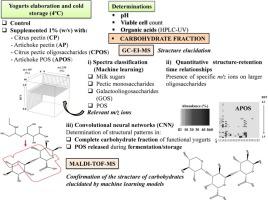当前位置:
X-MOL 学术
›
J. Food Compos. Anal.
›
论文详情
Our official English website, www.x-mol.net, welcomes your
feedback! (Note: you will need to create a separate account there.)
Carbohydrate fraction characterisation of functional yogurts containing pectin and pectic oligosaccharides through convolutional networks
Journal of Food Composition and Analysis ( IF 4.0 ) Pub Date : 2020-07-01 , DOI: 10.1016/j.jfca.2020.103484 Carlos Sabater , Celia Abad-García , Paloma Delgado-Fernández , Nieves Corzo , Antonia Montilla
Journal of Food Composition and Analysis ( IF 4.0 ) Pub Date : 2020-07-01 , DOI: 10.1016/j.jfca.2020.103484 Carlos Sabater , Celia Abad-García , Paloma Delgado-Fernández , Nieves Corzo , Antonia Montilla

|
Abstract The carbohydrate fraction of functional yogurts supplemented with citrus and artichoke pectin and their pectic oligosaccharides (POS) has been characterised, including carbohydrates from raw material (milk, pectin and POS) and formed during yogurt manufacture (POS and galactooligosaccharides GOS). Viable cell count and pH values accomplished the quality standards required for yogurts. The content of lactose and lactic and acetic acids was in the range 3.5–4.0; 0.85–1.16 and 0.04−0.07 g 100 g−1, respectively. Other sugars from pectin (arabinose, galacturonic acid, POS), milk (glucose, galactose, myo-inositol and GOS, GOS) were also quantified. GC-EI-MS spectra of yogurt carbohydrates were classified using machine learning, and structure-relative retention time relationships were calculated determining the abundance of specific fragments on larger oligosaccharide structures. All information generated was correlated using a convolutional network that established characteristic patterns in the complete carbohydrate fraction of each yogurt, as well as changes during fermentation in the carbohydrate profile. It was found that di-, tri- and tetra-POS formed by rhamnose and xylose attached to acetylated-galacturonic acid were released during fermentation in yogurts with artichoke POS. Structures elucidated by these algorithms were confirmed by MALDI-TOF-MS. These models may allow structural differences to be determined among novel oligosaccharides present in food matrices.
中文翻译:

通过卷积网络表征含有果胶和果胶寡糖的功能性酸奶的碳水化合物分数
摘要 添加了柑橘和朝鲜蓟果胶及其果胶低聚糖 (POS) 的功能性酸奶的碳水化合物部分已被表征,包括来自原材料(牛奶、果胶和 POS)以及在酸奶制造过程中形成的碳水化合物(POS 和低聚半乳糖 GOS)。活细胞计数和 pH 值达到了酸奶所需的质量标准。乳糖、乳酸和乙酸的含量在3.5-4.0之间;分别为 0.85–1.16 和 0.04-0.07 g 100 g-1。来自果胶(阿拉伯糖、半乳糖醛酸、POS)、牛奶(葡萄糖、半乳糖、肌醇和 GOS、GOS)的其他糖类也被量化。使用机器学习对酸奶碳水化合物的 GC-EI-MS 光谱进行分类,计算结构相对保留时间关系,确定较大寡糖结构上特定片段的丰度。所有生成的信息都使用卷积网络相关联,该网络在每种酸奶的完整碳水化合物部分中建立了特征模式,以及碳水化合物在发酵过程中的变化。研究发现,在含有朝鲜蓟 POS 的酸奶中发酵过程中会释放出由鼠李糖和木糖与乙酰化半乳糖醛酸结合形成的二、三和四 POS。由这些算法阐明的结构由 MALDI-TOF-MS 确认。这些模型可以确定食品基质中存在的新型寡糖之间的结构差异。所有生成的信息都使用卷积网络相关联,该网络在每种酸奶的完整碳水化合物部分中建立了特征模式,以及碳水化合物在发酵过程中的变化。研究发现,在含有朝鲜蓟 POS 的酸奶中发酵过程中会释放出由鼠李糖和木糖与乙酰化半乳糖醛酸连接形成的二、三和四 POS。由这些算法阐明的结构由 MALDI-TOF-MS 确认。这些模型可以确定食品基质中存在的新型寡糖之间的结构差异。所有生成的信息都使用卷积网络相关联,该网络在每种酸奶的完整碳水化合物部分中建立了特征模式,以及碳水化合物在发酵过程中的变化。研究发现,在含有朝鲜蓟 POS 的酸奶中发酵过程中会释放出由鼠李糖和木糖与乙酰化半乳糖醛酸结合形成的二、三和四 POS。由这些算法阐明的结构由 MALDI-TOF-MS 确认。这些模型可以确定食品基质中存在的新型寡糖之间的结构差异。在含有朝鲜蓟 POS 的酸奶中发酵过程中会释放由鼠李糖和木糖与乙酰化半乳糖醛酸连接形成的三和四 POS。由这些算法阐明的结构由 MALDI-TOF-MS 确认。这些模型可以确定食品基质中存在的新型寡糖之间的结构差异。在含有朝鲜蓟 POS 的酸奶中发酵过程中会释放由鼠李糖和木糖与乙酰化半乳糖醛酸连接形成的三和四 POS。由这些算法阐明的结构由 MALDI-TOF-MS 确认。这些模型可以确定食品基质中存在的新型寡糖之间的结构差异。
更新日期:2020-07-01
中文翻译:

通过卷积网络表征含有果胶和果胶寡糖的功能性酸奶的碳水化合物分数
摘要 添加了柑橘和朝鲜蓟果胶及其果胶低聚糖 (POS) 的功能性酸奶的碳水化合物部分已被表征,包括来自原材料(牛奶、果胶和 POS)以及在酸奶制造过程中形成的碳水化合物(POS 和低聚半乳糖 GOS)。活细胞计数和 pH 值达到了酸奶所需的质量标准。乳糖、乳酸和乙酸的含量在3.5-4.0之间;分别为 0.85–1.16 和 0.04-0.07 g 100 g-1。来自果胶(阿拉伯糖、半乳糖醛酸、POS)、牛奶(葡萄糖、半乳糖、肌醇和 GOS、GOS)的其他糖类也被量化。使用机器学习对酸奶碳水化合物的 GC-EI-MS 光谱进行分类,计算结构相对保留时间关系,确定较大寡糖结构上特定片段的丰度。所有生成的信息都使用卷积网络相关联,该网络在每种酸奶的完整碳水化合物部分中建立了特征模式,以及碳水化合物在发酵过程中的变化。研究发现,在含有朝鲜蓟 POS 的酸奶中发酵过程中会释放出由鼠李糖和木糖与乙酰化半乳糖醛酸结合形成的二、三和四 POS。由这些算法阐明的结构由 MALDI-TOF-MS 确认。这些模型可以确定食品基质中存在的新型寡糖之间的结构差异。所有生成的信息都使用卷积网络相关联,该网络在每种酸奶的完整碳水化合物部分中建立了特征模式,以及碳水化合物在发酵过程中的变化。研究发现,在含有朝鲜蓟 POS 的酸奶中发酵过程中会释放出由鼠李糖和木糖与乙酰化半乳糖醛酸连接形成的二、三和四 POS。由这些算法阐明的结构由 MALDI-TOF-MS 确认。这些模型可以确定食品基质中存在的新型寡糖之间的结构差异。所有生成的信息都使用卷积网络相关联,该网络在每种酸奶的完整碳水化合物部分中建立了特征模式,以及碳水化合物在发酵过程中的变化。研究发现,在含有朝鲜蓟 POS 的酸奶中发酵过程中会释放出由鼠李糖和木糖与乙酰化半乳糖醛酸结合形成的二、三和四 POS。由这些算法阐明的结构由 MALDI-TOF-MS 确认。这些模型可以确定食品基质中存在的新型寡糖之间的结构差异。在含有朝鲜蓟 POS 的酸奶中发酵过程中会释放由鼠李糖和木糖与乙酰化半乳糖醛酸连接形成的三和四 POS。由这些算法阐明的结构由 MALDI-TOF-MS 确认。这些模型可以确定食品基质中存在的新型寡糖之间的结构差异。在含有朝鲜蓟 POS 的酸奶中发酵过程中会释放由鼠李糖和木糖与乙酰化半乳糖醛酸连接形成的三和四 POS。由这些算法阐明的结构由 MALDI-TOF-MS 确认。这些模型可以确定食品基质中存在的新型寡糖之间的结构差异。









































 京公网安备 11010802027423号
京公网安备 11010802027423号